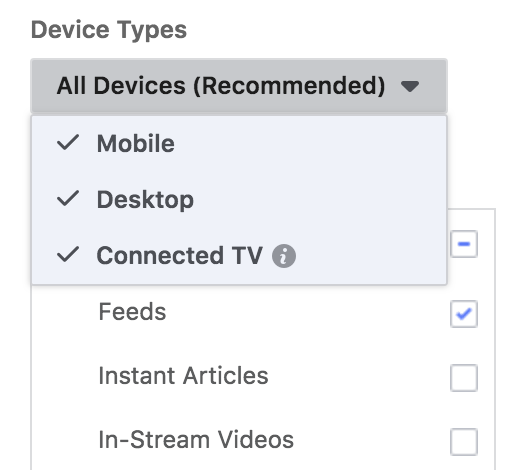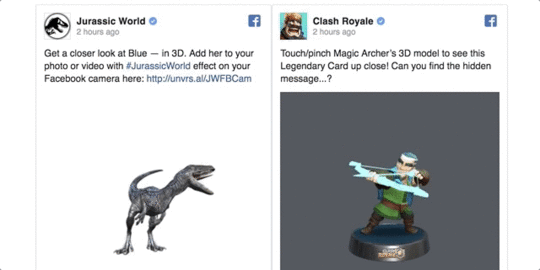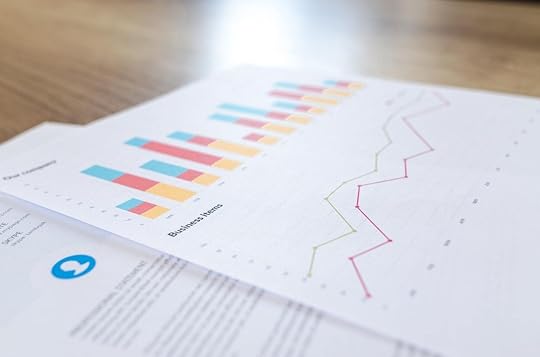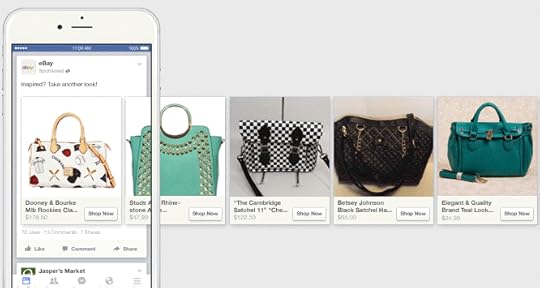Brian Meert's Blog, page 126
March 8, 2018
Facebook to End Its Test of Explore Feed
 March 7, 2018
March 7, 2018Anna Hubbel
@Facebook is discontinuing its test of #ExploreFeed because users don't want 2 feeds. #newsfeed #pagecontent
Click To Tweet Photo Courtesy of Facebook Newsroom
Photo Courtesy of Facebook Newsroom
The people have spoken: Explore Feed is out. Adam Mosseri, Facebook’s head of News Feed, announced in a Newsroom post that Facebook is ending its test of a second feed (Explore) as a result of feedback from users who indicated that they prefer only one feed.
Back in October 2017, Facebook tested Explore, a second feed designated only for page posts, not for posts by family and friends in the regular News Feed. Explore was intended for users who may want to switch between the type of content available to them based on their interests.
When Facebook first announced that News Feed would primarily show meaningful posts by family and friends, businesses were of course concerned about how that would affect content shared by their pages and if their content would be able to reach intended audiences. Explore Feed may have resolved that issue if the test had generated positive feedback.
However, Mosseri says users indicated in surveys that they do not want two separate feeds.
“We also received feedback that we made it harder for people in the test countries to access important information,” said Mosseri in the announcement, “and that we didn’t communicate the test clearly. We’re acting on this feedback by updating the way we evaluate where to test new products, and how we communicate about them.”
Additionally, Mosseri said Facebook is globally discontinuing the Explore Feed bookmark, which was intended to provide users a way of discovering new pages, celebrities, and other public figures.
Although the Explore Feed test did not end successfully, there are still ways businesses can boost reach organically.
The post Facebook to End Its Test of Explore Feed appeared first on AdvertiseMint.
March 7, 2018
Facebook Connected TV Ads: What You Need to Know
 March 7, 2018
March 7, 2018Anne Felicitas
Facebook is testing connected TV ads. #facebookads #connectedtv #advertising
Click To Tweet

For years digital advertisers have fantasized over the amalgamation of social media and TV advertising. Wouldn’t it be great, they mused, if we could harness the power of Facebook’s superior ad targeting and measurement capabilities in TV commercials? This once seemingly implausible hybrid is now a reality, thanks to Facebook’s product update. Recently, Facebook added connected TV on its list of placement options, allowing advertisers to serve video ads to users’ TV screens.
 Advertisers can choose connected TV as a placement option.
Advertisers can choose connected TV as a placement option.What Is Connected TV?
Connected TV, also known as a smart TV, uses the internet to access content that is not included in a user’s cable package; for example, content from OTT (over-the-top) services such as Netflix, HBO Go, Hulu, and Amazon. The types of connected TV that currently exist include Apple TV, Roku, Samsung, and Amazon Fire TV. Connected TV is particularly popular among viewers who prefer to stream their shows and movies. For some who prefer to only subscribe to OTT services, connected TV provides an inexpensive alternative to cable packages.
What You Need to Know About Facebook’s Connected TV Ads
When advertisers choose connected TV as their placement option, their ads will appear within the apps of Facebook’s Audience Network partners such as A&E, Lifetime, and History. Although Facebook has a Facebook TV app, which saves and plays videos users post to its platform, Facebook’s connected TV ads will not appear in Facebook’s TV app.
To run a connected TV ad, advertisers must choose either the video views, brand awareness, or engagement objectives. They must then either choose Automatic Placements or Edit Placements. If the latter, they must check the devices connected TV and mobile with the placement option Audience Network.
Advertisers may feel apprehensive about the type of content their ads will appear in. An advertiser may not want her brand dedicated to veganism to appear in a show about meat eating. Or a business owner selling children’s apparel may not want his ads to appear within an episode of Game of Thrones. Advertisers who worry about brand safety can use Facebook’s category blocking and block lists to prevent ads from appearing in content that could jeopardize their brands’ images.
 Advertisers can use category blocking and block lists.
Advertisers can use category blocking and block lists.The new connected TV placement option is currently a test only available in the US. Although available in that country, the placement, because it’s still a test, may not be available to all advertisers. The advertisers to whom it is available can place their videos on connected TVs in the form of in-stream video ads, ads that appear before or during a video. Because the video ads are in-stream, advertisers must ensure that their videos run 15 seconds at most. Additionally, they must comply with Facebook’s ad specs and creative requirements, including a resolution of 1080 pixels at the maximum and an aspect ratio of 16:9.
 Facebook requires advertisers to follow the creative requirements for Connected TV ads.
Facebook requires advertisers to follow the creative requirements for Connected TV ads.Announcements that Facebook will allow ad placement to connected TVs first hit headlines in 2016 when Facebook revealed ads will appear in Apple TV and Roku. However, the placement was not yet available to advertisers during that time.
The Benefits of Connected TV Ads
With Facebook’s connected TV ads, advertisers can bring Facebook’s measurement and targeting tools to TV advertising. As they would with regular Facebook ads, advertisers use Facebook’s targeting options to target their desired viewers. Facebook will then attempt to match the targeted viewer in the house with the connected TV. After advertisers run the ad, they will receive a report called Connected TV for all standard video metrics available, such as impressions, in their Business Managers. This report is accessible by choosing placement and device when breaking down results.
Additionally, with connected TV ads, advertisers can target an attentive lean-back audience comprised of viewers most likely to watch the video in its entirety. These viewers are most likely sitting on their couches, waiting for the ad to finish and their shows to resume.
Connected TV: An Alternative to News Feed
During the past two years, Facebook has been exploring placement options outside of News Feed. Before connected TV, Facebook opened advertising to Instagram Stories, Watch, live videos, Marketplace, Messenger home, and Audience Network. These efforts came after it became apparent to the social media company that News Feed is becoming overpopulated and cluttered, resulting in higher bids for ad spots and more distractions from the coveted users’ attentions. The new placement, connected TV, will hopefully free up ad space.
The post Facebook Connected TV Ads: What You Need to Know appeared first on AdvertiseMint.
March 5, 2018
Do Not Overlook Social Media Marketing. Here’s Why (Infographic)
 March 6, 2018
March 6, 2018Josh Wardini
This infographic shows you everything you need to know about social media. #socialmediamarketing #socialcommerce #facebookads
Click To Tweet
As much as we don’t want to admit it, most of us are very close to becoming social media addicts. And why not? There are endless possibilities that the internet offers, and we are not shy to use them. A social media account has many purposes. Got promoted? Tell your friends. Are you bored? Browse through your Facebook feeds.
Today, however, social media is increasingly used for a different cause. Business owners are finally using social media marketing to promote their services and facilitate the way people buy. With helpful features such as Facebook Marketplace, Ebay Daily Deals, Pinterest Buyable Pins, and Sponsored Tweets, social commerce has brought business owners a world of opportunities. Shopping has never been easier.
I’ve said it once. I’ll say it thousand times more: social media is your ticket to reaching the right audience most likely to convert. Social media influences customers to buy. In fact, 87 percent of shoppers have bought something after consulting social media.
Not only does social media influence customers’ purchase decisions, but it also creates a platform where brands and customers can interact, with brands listening to their suggestions and integrating new ideas into their business plans. Fifty-nine percent of US shoppers acknowledge that customer service through social media has answered all their doubts and made it easier to resolve any issues.
Social media marketing is a relatively new trend which continues to break records.
The infographic below shows you why incorporating social media into your digital marketing strategy can drastically improve your business.

This infographic was provided by Josh Wardini, the community manager at Webmastersjury.
The post Do Not Overlook Social Media Marketing. Here’s Why (Infographic) appeared first on AdvertiseMint.
March 4, 2018
Twitter Is Changing Platform and API Rules to Prevent Misuse
 March 5, 2018
March 5, 2018Anna Hubbel
@Twitter is making platform & API rule changes to prevent misuse & the spread of #FakeNews. #TwitterChanges #TwitterAccounts
Click To Tweet

Fake news appears to be everywhere lately, especially during investigations of Russian troll Facebook accounts linked to politically divisive ads distributed during the 2016 US presidential election. In response, social networks like Facebook have been taking measures to prevent the spread of fake news and overall account misuse.
Twitter is also taking action in the fight. To deter the misuse of bots and automated systems to boost follower numbers and spread fake news, the social networking site recently announced some changes in its platform and rules. A Twitter blog post announced some new changes to the Twitter system and API usage rules.
Rule Change #1
“Do not (and do not allow your users to) simultaneously post identical or substantially similar content to multiple accounts. For example, your service should not permit a user to select several accounts they control from which to publish a given Tweet.”
This change applies to both Tweets published simultaneously and those that are scheduled. Twitter said retweeting posts between accounts is permissible but should not be done excessively or in high volumes.
Rule Change #2
“Do not (and do not allow your users to) simultaneously perform actions such as Likes, Retweets, or follows from multiple accounts. For example, your service should not permit a user to select several accounts they control to follow a specified account.”
This rule is intended to prevent spammy behaviors.
Rule Change #3
“The use of any form of automation (including scheduling) to post identical or substantially similar content, or to perform actions such as Likes or Retweets, across many accounts that have authorized your app (whether or not you created or directly control those accounts) is not permitted. For example, applications that coordinate activity across multiple accounts to simultaneously post Tweets with a specific hashtag (e.g. in an attempt to cause that topic to trend) are prohibited.”
This rule further discourages spammy behavior in preventing accounts from manipulating trends rather than allow them to trend organically. This rule stands unless the behavior is performed by an authorized app to disseminate emergency or public service announcements.
The aforementioned rules are now in effect for Tweet Deck users. All users who engage in any of the now-restricted behaviors across multiple accounts need to comply with the new rules by March 23, 2018. Users who don’t comply with these rules will face consequences such as suspensions of associated applications and accounts.
Cracking Down on Fake News
According to Social Media Today, there are approximately 49.5 million fake Twitter accounts. The problem that Twitter is going to face in light of its crackdown on fake accounts is a drastic decrease in users across the platform. Social Media Today says Twitter is going to need to prove to users that they don’t need to falsify accounts and misuse the platform to build a strong following.
The post Twitter Is Changing Platform and API Rules to Prevent Misuse appeared first on AdvertiseMint.
Mobile Insights: How Users Spend Their Time on Mobile Devices
 March 4, 2018
March 4, 2018Anna Hubbel
@Emarketer shared its US estimates on mobile behaviors to help marketers get the most out of their mobile strategies in #2018. #mobileapps #digitaladvertising #adspend
Click To Tweet

The various ways users engage with their mobile devices reveal valuable information about the best way to market to them. Marketing data and research analyst Emarketer shared its US estimates on mobile behaviors to help marketers get the most out of their mobile strategies in 2018.
US Mobile Internet Usage
Smartphone Internet users make up 93.4 percent of all Internet usage in the US, according to Emarketer. Out of 223 million mobile phone Internet users total, 219.8 million are smartphone users (up 6.1 percent from 2016). An estimated 157.4 million users are tablet Internet users (up 4.6 percent from 2016).
Mobile-only Internet users (including tablets, smartphones, and feature phones) are up 11.1 percent from 2016, whereas desktop- and laptop-only Internet users are down 11.8 percent from 2016. While users may continue to use a combination of desktop or laptop and mobile to use the Internet, Emarketer expects desktop- and laptop-only Internet usage to continue to decline.
Mobile Ad Spend
US mobile ad spending totaled $58.38 billion in 2017, up 25 percent from 2016. An estimated $45.26 billion of that total went towards in-app ads. Additionally, ad spend invested in mobile was double the ad spend in desktop.
Mobile Ad Formats
Mobile display formats (video, rich media, and banner) make up 51.8 percent of mobile ad spend. Within that percentage, mobile video makes up 10.2 percent, mobile rich media makes up 16.7 percent, and mobile banner or other makes up 24.9 percent. In contrast, mobile search makes up 44 percent of mobile ad spend. Emarketer attributes the bigger investment in mobile display formats to the increasing consumer usage of social networking and mobile video consumption.
Mobile and Social
About 174.4 million users take part in social networking on their mobile phones (up 6.9 percent from 2016). One hundred fifty-seven users engage with Facebook on their mobile phones while 84.7 million and 79.2 million engage with Instagram and Snapchat on their mobile phones, respectively. Although the growth rate for mobile social networking has decreased to single-digit percentages, Emarketer says growth for mobile is still faster.
Mobile Time Spent and Activities
Primarily, Emarketer says users spend their mobile time in apps, making up 84 percent of total mobile Internet time. As for time spent in browsers on mobile devices, it’s frequent, but very brief, making up only 15 percent of total mobile Internet time.
Out of the total amount of time spent on mobile Internet, 34 percent is spent on tablets and 65.3 percent is spent on smartphones. Tablet browser usage makes up only 23 percent of tablet Internet time, with tablet app usage making up 77 percent of tablet Internet time. Smartphone browser usage makes up only 11 percent of smartphone Internet time, with smartphone app usage making up 89 percent of smartphone Internet time.
As for app usage overall, mobile social-network app usage makes up 23.9 percent of mobile app time; mobile game apps make up 14.3 percent; mobile video apps make up 18.7 percent, and other app activities make up 43.1 percent.
When considering mobile strategies, it’s also important to create stunning app designs.
The post Mobile Insights: How Users Spend Their Time on Mobile Devices appeared first on AdvertiseMint.
March 3, 2018
Facebook 3D Posts Now Support Standard glTF 2.0 File Format
 March 3, 2018
March 3, 2018Anna Hubbel
@Facebook #3D posts now support the standard glTF 2.0 file format. #ARadvertising #ARcommerce
Click To Tweet Photo Courtesy of TechCrunch
Photo Courtesy of TechCrunch
Back in October, Facebook teased interactive 3D objects in News Feed. Now, Tech Crunch says Facebook is adding the final touches to stages one and two of its 3D posts, and the results are exciting for both developers and users alike.
According to Tech Crunch, these 3D posts will now support the standard glTF 2.0 file format, which means developers can enjoy textures, lighting, and realistic rough or shiny rendering for their models.
How It Works
Developers can now make 3D modeling apps or cameras to share on News Feed. Even websites can be featured as 3D posts.
On the user side, 3D objects can be dragged, moved, and dropped into News Feed, as well as brought into Facebook Spaces, the network’s VR hangout space, as a post.
When creating a post containing a 3D model, Tech Crunch says users can choose a background color and texture.
“We’re trying to make 3D a native part of the Facebook ecosystem. Stage 3 is getting these 3D objects into AR,” Facebook’s creative director for social VR, Ocean Quigley, says in a Tech Crunch article. “We’re trying to lay the foundational steps so Facebook can go with users into their 3D worlds of VR and AR.”
The ultimate hope is that the process of developing and sharing 3D posts is as seamless and convenient as possible, requiring only the minimum level of tech skills so anyone can do it.
With glTF 2.0 referred to as the “JPEG of 3D” by Quigley, Tech Crunch says Facebook is open sourcing converters on GitHub to make it easy to convert to this file type, which is preferred by Facebook.
The Future: AR Commerce
As Facebook continues to explore new AR (augmented reality) capabilities, the future of digital advertising will likely come in the form of AR commerce. Rather than displaying products in photos or static images, advertisers would create 3D models of their products for a more interactive and exciting shopper experience.
Facebook’s AR exploration is a direct response to competition presented by Snapchat. In December, Facebook rolled out AR Studio, a creative tool for making AR experiences, to creators worldwide.
One thing is definitely certain: the future of digital advertising is going to be advanced by AR capabilities in one way or another. The only question is how soon.
The post Facebook 3D Posts Now Support Standard glTF 2.0 File Format appeared first on AdvertiseMint.
March 2, 2018
Snapchat Is Offering Free Ads to Small Startups
 March 2, 2018
March 2, 2018Anna Hubbel
#Snap is offering #free @Snapchat ads to small #startups. #YCombinator #digitaladvertising
Click To Tweet Snap CEO Evan Spiegel, Photo Courtesy of Recode
Snap CEO Evan Spiegel, Photo Courtesy of Recode
Snap is the Oprah Winfrey of social media advertising as of late, announcing yet again more free ad giveaways. Only this time, the company is offering free ads to startups linked with Silicon Valley startup accelerator programs such as Y Combinator.
Earlier this month, Snap announced that it was offering free ad credits to advertisers who use Instagram, trying to lure the market away from its biggest competitor. Now, according to Recode, Snap is luring companies currently participating or having participated in these accelerator programs with hundreds of dollars’ worth of free Snapchat ads and first dibs on new ad products and creative tools.
Building Relationships
This free ad giveaway is Snap’s attempt to build stronger relationships with advertisers and, subsequently, increase the number of bids for ad spots. Currently, because there aren’t many competitive bids taking place for Snapchat ad spots, prices and ad revenue don’t increase. The bottom line: better relationships mean more advertisers, and more advertisers mean more bids, mean higher prices.
According to Recode, Snap is also looking at the following accelerator programs: General Catalyst’s Rough Draft Ventures, First Round Capital’s Dorm Room Fund, Berkeley-based The House and San Francisco-based Runway.
The post Snapchat Is Offering Free Ads to Small Startups appeared first on AdvertiseMint.
March 1, 2018
Facebook to Remove Redundant and Outdated Ad Metrics in July
 March 1, 2018
March 1, 2018Anna Hubbel
@Facebook to remove redundant & outdated ad metrics in July. #admeasurement #digitaladvertising
Click To Tweet

In addition to making clearer labels for its ad metrics, Facebook plans to remove some metrics that have been deemed redundant, outdated, not actionable, or infrequently used. Facebook believes removing these metrics will allow advertisers to easily analyze their metrics and determine which are most insightful and useful in constructing optimal marketing strategies and campaigns. The following metrics are the ones Facebook plans to remove come July 2018, along with suggestions for alternative metrics to use in place of them.
Actions, People Taking Action, Cost per Any Action
In place of these metrics, Facebook advises advertisers to customize their own composite metric to represent actions of significant insight specific to the business.
Amount Spent Today
Facebook’s dynamic date selector is more useful than the amount spent today metric when it is used to see results for today and then analyzed in comparison to other date ranges.
Button Clicks
Facebook says this metric is nearly identical to measurements reflected in link clicks, event responses, and offers saved, which, once the button clicks metric is removed, should be used instead.
Canvas Component Time Percentage
Since this metric isn’t often used, Facebook recommends using canvas view time and canvas view percentage instead.
Carousel Card
This metric will no longer provide a breakdown of conversion metrics or of any calculated metrics because it is rarely used. However, Facebook says link clicks can be broken down by carousel card to see conversion results.
Link Click Destination
Outbound clicks and landing page views can be used for the time being to measure clicks leading to off-Facebook destinations. These metrics can also provide a more effective granular insight to app deep links or app store destinations.
Mobile App Actions Conversion Value
Facebook says using specific app event conversion values such as mobile app purchases conversion value is more useful than this metric.
Page Mentions, Cost per Page Mention
These metrics are outdated and do not reflect any significant insights, according to Facebook. Page likes or page engagement are recommended in place of them.
Page Tab Views, Cost per Page Tab View
These metrics are redundant and not as meaningful as page likes or page engagement.
Positive Feedback, Negative Feedback
Similar to the relevance score metric, these two metrics will only confuse advertisers. Relevance score is more useful in understanding how well a target audience is responding to ads.
Social Reach, Social Impressions, Social Clicks (All), Unique Social Clicks (All)
Facebook says these metrics are outdated and are similar to reach and impressions.
The post Facebook to Remove Redundant and Outdated Ad Metrics in July appeared first on AdvertiseMint.
February 28, 2018
3 Marketing Trends to Look for in 2018 According to Marketing Experts
 March 1, 2018
March 1, 2018Anna Hubbel

The year 2018 is expected to be one of excitement, opportunity, and even fearful uncertainty for businesses that incorporate digital advertising into their marketing strategies. Bronto, a lead email marketing service provider for e-commerce retailers, recently shared predictions from e-commerce marketing experts regarding digital marketing trends for 2018. Here are the major points of interest the experts discussed about the future of digital marketing.
3 trends to look out for in 2018: #AI & #MachineLearning, #Amazon, and #Personalization, #Brand, & Unique Content. #BrontoPredictions #marketingexperts
Click To Tweet
1. Artificial Intelligence and Machine Learning

Peter Sheldon, vice president of strategy at Magento Commerce, says although the idea of artificial intelligence (AI) is exciting and will make small advances in 2018, it isn’t something brands should dedicate most of their marketing efforts on quite yet.
“You might see it in conversational or browserless commerce, but I think we’re kidding ourselves if we think there’s going to be some drastic change in the way consumers buy through digital channels because of AI,” says Sheldon.
However, Zak Stambor, editor at Internet Retailer, says, “For most retailers, AI and machine learning seem most likely to transform the way retailers approach their digital marketing efforts.” Going into 2018, Stambor predicts a spike in marketing strategies that incorporate artificial intelligence and machine learning. Retailers will need to keep up with these technological advancements and find ways to stand out in the crowd.
Greg Zakowicz, senior commerce marketing analyst at Bronto Software, says although browserless devices (e.g., Amazon Echo, Google Assistant) are increasing in popularity and becoming the norm, brands or sites with high reviews or low-cost but good-quality products don’t need to worry yet. However, browserless commerce is still something businesses will need to keep an eye on as technological improvements continue at a fast pace.
Zakowicz offers the following thoughts:
“If browserless shopping and voice search become an everyday occurrence, could offline marketing come back into play? Are there ways to rent or purchase data from companies that have browserless systems to pair with existing customer relationship databases? The data needed by retailers to narrowly target customers will be owned by whatever company is collecting it through their [sic] device. Retailers could purchase or rent targeted data from these companies for direct mail or other types of advertising techniques. Theoretically, they would even be able to fine-tune the types of customers they are targeting (e.g. location, lifestyle and real-time browse history).”
2. Amazon

For independent brands, Amazon is either a friend or a foe in the e-commerce world because it is rising as a competitive advertising platform. According to Zak Stambor, if a brand doesn’t want to give Amazon a chance, they need to find a unique way to stand out on their own.
“Retailers that don’t want Amazon to take their market share need to be different,” says Stambor. “They need to find ways to distinguish themselves.”
Peter Sheldon, too, believes staying away from Amazon is a “dangerous game.”
“If you haven’t embraced their marketplace, now is the time,” says Sheldon. “It’s where the eyeballs are.”
3. Personalization, Brand, and Unique Content
 An example of a Dynamic Product Ad
An example of a Dynamic Product Ad Saima Alibhai, managing principal consultant at EMEA believes “the trend for 2018 is how you use technology to connect with your customer[s], anticipate their needs and supply them. It’s not about promoting what you want to promote.”
In other words, brands need to think one step ahead, using information they’ve gathered about each individual customer through technology to predict what’s important to them.
Vivek Sharma, CEO of Movable Ink, says machine learning will be an effective tool in 2018 for personalizing the brand experience for consumers. But that shouldn’t be mistaken for handing over the creative process to machine learning entirely. Sharma explains that machine learning should be used to scale human creativity, enhancing a brand’s creativity by automating communication for a personalized experience.
“The intriguing aspect of visual personalization is that it doesn’t require the message to be constantly changed out,” says Sharma. “You could conceivably breathe a bit of life into what is, technically, a batch-and-blast email, just one that will automatically render differently depending on the recipient.’’
Authenticity, engagement, easiness, and creativity will be crucial in 2018, according to John Swords, chief product officer at TurnTo. Specifically, he believes user-generated content (UGC) will be popular.
“UGC outranks all other forms of marketing, including search engines, when it comes to shopper influence,’’ Swords says. He adds, “[UGC] helps build trust and offers a more authentic shopping experience.’’
It’ll be worth it, Swords believes, for brands and retailers to somehow incorporate UGC into their marketing strategies in 2018.
Dylan Whitman, founder and CEO of BVAccel, says embracing technology is going to be extremely important for retailers in 2018, but that it will only be effective if the brand doesn’t have a unique element that gives it value.
“You deliver truths with every interaction with your customers,” says Whitman. “You build a relationship of trust with that customer so they’ll pick your brand based on that relationship over others.”
One of the ways brands can make this juxtaposition is through personalized and automated emails, says Whitman.
Peter Sheldon concurs that unique content is going to make it or break it for most brands in 2018. “The firms that are obsessed with unique content, how-to guides and videos are going to succeed,” says Sheldon.
Greg Zakowicz says retailers are starting to combine their online and offline efforts to bring more customers to their brick-and-mortar stores.
“Buy online and pick up in-store (BOPIS) is gaining in popularity,” says Zakowicz, “so streamlining this experience will be critical for retailers that want to encourage consumers to get off the couch and go to the store.”
Zakowicz explains that joining online with offline to form an omnichannel experience creates a bond between brand and consumer, which is vital in establishing brand loyalty. In addition, connecting with customers online to get them to visit the brick-and-mortar store increases the likelihood that they’ll make more purchases on top of the ones they made or planned to make online.
In addition to these experts’ predictions, Emarketer forecasts that 10 percent of total US ad spending in 2018 will go towards Facebook.
The post 3 Marketing Trends to Look for in 2018 According to Marketing Experts appeared first on AdvertiseMint.
3 Marketing Trends to Look For in 2018 According to Marketing Experts
 March 1, 2018
March 1, 2018Anna Hubbel

The year 2018 is expected to be one of excitement, opportunity, and even fearful uncertainty for businesses that incorporate digital marketing into their advertising strategies. Bronto, a lead email marketing service provider for e-commerce retailers, recently shared predictions from e-commerce marketing experts regarding digital marketing trends for 2018. Here are the major points of interest the experts discussed about the future of digital marketing.
3 trends to look out for in 2018: #AI & #MachineLearning, #Amazon, and #Personalization, #Brand, & Unique Content. #BrontoPredictions #marketingexperts
Click To Tweet
1. Artificial Intelligence and Machine Learning

Peter Sheldon, vice president of strategy at Magento Commerce, says although the idea of artificial intelligence (AI) is exciting and will make small advances in 2018, it isn’t something brands should dedicate most of their marketing efforts on quite yet.
“You might see it in conversational or browserless commerce, but I think we’re kidding ourselves if we think there’s going to be some drastic change in the way consumers buy through digital channels because of AI,” says Sheldon.
However, Zak Stambor, editor at Internet Retailer, says, “For most retailers, AI and machine learning seem most likely to transform the way retailers approach their digital marketing efforts.” Going into 2018, Stambor predicts a spike in marketing strategies that incorporate artificial intelligence and machine learning. Retailers will need to keep up with these technological advancements and find ways to stand out in the crowd.
Greg Zakowicz, senior commerce marketing analyst at Bronto Software, says although browserless devices (e.g., Amazon Echo, Google Assistant) are increasing in popularity and becoming the norm, brands or sites with high reviews or low-cost but good-quality products don’t need to worry yet. However, browserless commerce is still something businesses will need to keep an eye on as technological improvements continue at a fast pace.
Zakowicz offers the following thoughts:
“If browserless shopping and voice search become an everyday occurrence, could offline marketing come back into play? Are there ways to rent or purchase data from companies that have browserless systems to pair with existing customer relationship databases? The data needed by retailers to narrowly target customers will be owned by whatever company is collecting it through their [sic] device. Retailers could purchase or rent targeted data from these companies for direct mail or other types of advertising techniques. Theoretically, they would even be able to fine-tune the types of customers they are targeting (e.g. location, lifestyle and real-time browse history).”
2. Amazon

For independent brands, Amazon is either a friend or a foe in the e-commerce world because it is rising as a competitive advertising platform. According to Zak Stambor, if a brand doesn’t want to give Amazon a chance, they need to find a unique way to stand out on their own.
“Retailers that don’t want Amazon to take their market share need to be different,” says Stambor. “They need to find ways to distinguish themselves.”
Peter Sheldon, too, believes staying away from Amazon is a “dangerous game.”
“If you haven’t embraced their marketplace, now is the time,” says Sheldon. “It’s where the eyeballs are.”
3. Personalization, Brand, and Unique Content
 An example of a Dynamic Product Ad
An example of a Dynamic Product Ad Saima Alibhai, managing principal consultant at EMEA believes “the trend for 2018 is how you use technology to connect with your customer[s], anticipate their needs and supply them. It’s not about promoting what you want to promote.”
In other words, brands need to think one step ahead, using information they’ve gathered about each individual customer through technology to predict what’s important to them.
Vivek Sharma, CEO of Movable Ink, says machine learning will be an effective tool in 2018 for personalizing the brand experience for consumers. But that shouldn’t be mistaken for handing over the creative process to machine learning entirely. Sharma explains that machine learning should be used to scale human creativity, enhancing a brand’s creativity by automating communication for a personalized experience.
“The intriguing aspect of visual personalization is that it doesn’t require the message to be constantly changed out,” says Sharma. “You could conceivably breathe a bit of life into what is, technically, a batch-and-blast email, just one that will automatically render differently depending on the recipient.’’
Authenticity, engagement, easiness, and creativity will be crucial in 2018, according to John Swords, chief product officer at TurnTo. Specifically, he believes user-generated content (UGC) will be popular.
“UGC outranks all other forms of marketing, including search engines, when it comes to shopper influence,’’ Swords says. He adds, “[UGC] helps build trust and offers a more authentic shopping experience.’’
It’ll be worth it, Swords believes, for brands and retailers to somehow incorporate UGC into their marketing strategies in 2018.
Dylan Whitman, founder and CEO of BVAccel, says embracing technology is going to be extremely important for retailers in 2018, but that it will only be effective if the brand doesn’t have a unique element that gives it value.
“You deliver truths with every interaction with your customers,” says Whitman. “You build a relationship of trust with that customer so they’ll pick your brand based on that relationship over others.”
One of the ways brands can make this juxtaposition is through personalized and automated emails, says Whitman.
Peter Sheldon concurs that unique content is going to make it or break it for most brands in 2018. “The firms that are obsessed with unique content, how-to guides and videos are going to succeed,” says Sheldon.
Greg Zakowicz says retailers are starting to combine their online and offline efforts to bring more customers to their brick-and-mortar stores.
“Buy online and pick up in-store (BOPIS) is gaining in popularity,” says Zakowicz, “so streamlining this experience will be critical for retailers that want to encourage consumers to get off the couch and go to the store.”
Zakowicz explains that joining online with offline to form an omnichannel experience creates a bond between brand and consumer, which is vital in establishing brand loyalty. In addition, connecting with customers online to get them to visit the brick-and-mortar store increases the likelihood that they’ll make more purchases on top of the ones they made or planned to make online.
In addition to these experts’ predictions, Emarketer forecasts that 10 percent of total US ad spending in 2018 will go towards Facebook.
The post 3 Marketing Trends to Look For in 2018 According to Marketing Experts appeared first on AdvertiseMint.



